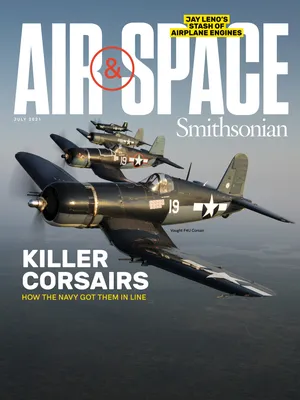This New Hampshire Bookstore Has Its Own Air Force
You never know what you’ll find on—make that above—the shelves.
:focal(907x1787:908x1788)/https://tf-cmsv2-smithsonianmag-media.s3.amazonaws.com/filer/53/bc/53bcb0c7-9d9c-42cd-8bc4-5e304e6f714f/05b_jj2021_billattoadstoolcropexitsign_live.jpg)
On a recent visit to scenic Peterborough, New Hampshire, I stopped in to browse at the Toadstool Bookshop and was surprised by the galaxy of model airplanes suspended from the ceiling. After my initial surprise (and delight) at the size of the collection—there must have been 300 airplanes dangling over the store’s used-book section—my sense of wonderment increased when I noticed that it contained not only famous airplane types that almost anyone would recognize but also rare and fairly obscure aircraft that I, as a former naval aviator, was drawn to. When I asked the sales clerk, “How did these models get here?” I learned about Bill Johnson.
Johnson had been building model airplanes since he was a kid, and he held onto his collection, believing that someday they’d serve a purpose. That purpose materialized in 1980 when Johnson started his career as a special needs education teacher for teenagers with autism and behavioral problems. Knowing he had to stimulate discussion to get the kids focused on something outside themselves, Johnson started building models from kits for display in his classroom. After the stress of working with sometimes volatile students, the “focused, predictable, creative activity,” as he called it, was therapeutic.
The models quickly became popular with his students as well. They greeted each new airplane with questions that allowed him to weave in lessons on science, geography, and history.
As an avid aviation history buff, he specialized in little known aircraft with unusual markings or paint schemes. A group of different warplanes—a PZL P.11 fighter and PZL.23 light bomber—flown by the Poles in their desperate attempt to stop the 1939 Nazi onslaught, led to a lesson about the origins of World War II. A Dornier 28 Skyservant in Red Cross livery prompted discussions of a 1960s humanitarian airlift in West Africa, estimated to have saved nearly a million people from starvation.
Johnson soon realized that his students were impressed by his work, and he began trying harder to craft his kits into objects with a museum-like quality. The models became a cherished part of the classroom.
Upon retirement, Johnson needed a place to display this vast collection. Fortunately, his friend Jeff Osgood, who manages the Toadstool’s used-book section, thought the models would draw customers, and suggested the display. “It worked,” says Osgood. “Many people recall making models as kids and comment on how a father, brother or son would love to see them.” And he adds: “Visitors always ask how many people did the models, and are astonished that one person did so many.” One customer commented on childhood memories stirred by the bookstore’s collection. “As a young girl during the war, she recalled playing the [Airplane] Spotter Game,” says Osgood. “And in many ways, that game continues here in the store.”
Although Johnson, who suffers from neuropathy, no longer makes models, he volunteers at the bookstore and says the models still spark discussion. He recalls a conversation he had with a World War II veteran who regaled him with tales of mock dogfights over the Florida Everglades while training to fly Grumman fighters. Johnson made him a Hellcat model, which the vet picked up a few weeks later. “He was grinning from ear to ear,” Johnson says.
Then there was the Vietnam veteran who, gazing up at the collection, noticed there wasn’t a Grumman A-6 Intruder hanging overhead. The former Marine pilot offered to send Johnson a model of the Intruder. “But there was a proviso,” says Johnson. Though most of the A-6s lost on bombing runs in Vietnam were hit by ground fire, “he insisted that it be displayed far away from any MiGs.”
For those of us who can’t help looking skyward every time we hear an airplane overhead, the “Toad” is a wonderful place to browse—for a book or an airplane.
